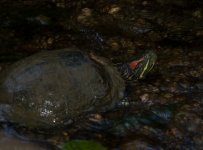no they are carnivorous actually primarily pescivorous but they can't do much damage, particularly when compared with other invasive alien species which we have on our shores currently.
QUOTE]
No, from what I’ve been able to learn, adult sliders are basically herbivorous, eating relatively little animal food. See, for example, the following excerpt from “The Biogeography of the Red-eared Slider” (
http://bss.sfsu.edu/holzman/courses/fall01 projects/reslider.htm).
“Young sliders tend to be more carnivorous than adults; eating about 70% animal matter and 30% plant matter. Adults eat 90% plant matter and 10% animal matter (Wilke 1979). Foods include aquatic snails, tadpoles, crawfish, fish, crustaceans and mollusks. They also eat plants like arrowhead, water lilies, hyacinths and duckweed. Feeding occurs under water, usually late in the afternoon (Dawson 1998)”.
None of the sources I’ve looked at so far so much as mentions young birds as a component of RE Slider diet.
other than it actualy having been filmed and shown on british tv a couple of weeks ago, adult sliders do take the odd newly fledged duckling, they will more frequently scavenge newly dead carcases though.
they make great garbage men.
keith what you and cheshire birder are failing to grasp here is they hardly actualy eat anything at all, the amount of food which is required to keep a mammal alive for one month will last a reptile for 10.
i had 4 red eared sliders which were kept in optimum conditions, for growth back in the 80's i used to feed them 1 small piece of mince eavh every couple of days or a thumnail sized piece of liver, a gold fish would last the 4 of them a week, these were rapidly growing.
a fully grown turtle actually requires less food proportionaly than a growing one, if one kills a malard chick it will last 3 fully grown ones for about a week if they eat nothing else and they would have to eat nothing else and get lots of rays in order to actualy digest it. other wise it would rot in their stomach and kill them.
and in case anyone is wondering no i didn't release mineinto the wild i got the calcium suplementation of their diet wrong and they all eventualy died of mbd. because little information was available at the time.




